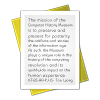Description
The SRI ARC/NIC records contain material from Stanford Research Institute’s Augmentation Research Center (ARC) and Stanford Research Institute’s Network Information Center (NIC) project. The bulk of the collection is from 1968 through 1991. The collection documents the development of Dr. Douglas Engelbart’s NLS/Augment system, which first embodied many personal computer concepts such as direct user interaction with a computer and use of hypertext. Materials of note include the protocol work of Dr. Jonathan Postel and other ARC members, the original patent for the computer “mouse,” NLS source code, and the ARC journal. In addition, the collection covers the role and work of the Arpanet DDN NIC, which was the information hub of the early Internet before the advent of the World Wide Web. Included are a wide variety of documents pertaining to the development of the early Internet including its design, administration, information flow, research projects, programs, protocol development, working groups, naming and addressing development, and lists of early participants. Types of material include technical notes, proposals, reports, reprints, correspondence, videos, dump tapes, photographs, seminar presentations, protocols, working group papers, and bibliographies.
Date
ca. 1959-2006; bulk 1968-1990
Author
Feinler, Elizabeth "Jake"
Publisher
Computer History Museum
Extent
351 linear feet; 281 boxes
Category
Finding Aid
Subject
Feinler, Elizabeth J.; Postel, Jonathan Bruce; Stanford Research Institute. Augmentation Research Center (SRI ARC); Stanford Research Institute. Network Information Center (SRI NIC); SRI International. Network Information Center; ARPANET (Computer network); MILNET (Computer network); DDN (Computer network); United States. Defense Advanced Research Projects Agency; United States. Defense Communications Agency; Human-machine systems; NLS/Augment; TCP/IP (Computer network protocol); Engelbart, Douglas
Collection Title
SRI ARC/NIC records
Credit
Gift of Elizabeth J. Feinler


